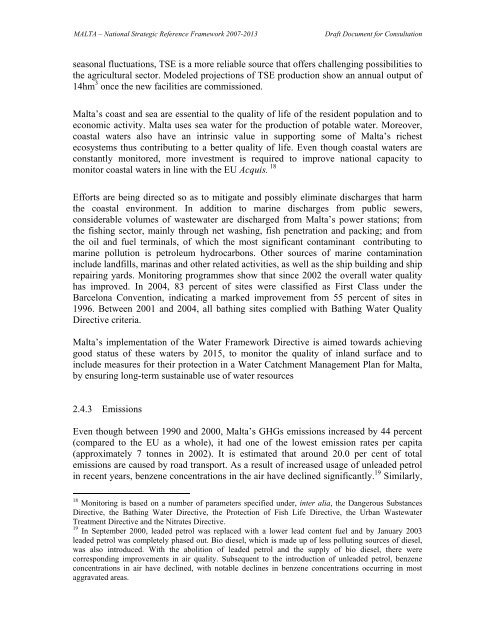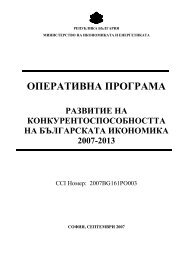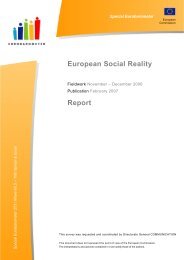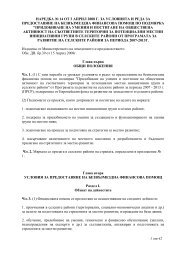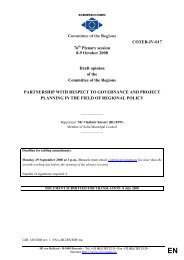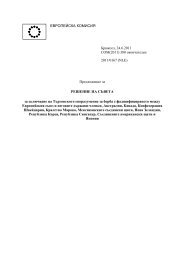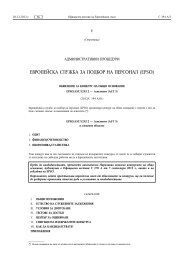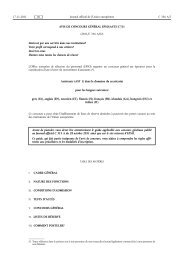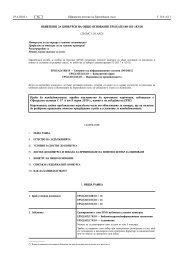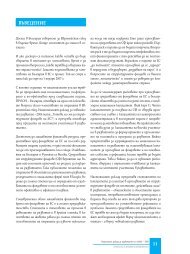National Strategic Reference Framework
National Strategic Reference Framework
National Strategic Reference Framework
You also want an ePaper? Increase the reach of your titles
YUMPU automatically turns print PDFs into web optimized ePapers that Google loves.
MALTA – <strong>National</strong> <strong>Strategic</strong> <strong>Reference</strong> <strong>Framework</strong> 2007-2013 Draft Document for Consultation<br />
seasonal fluctuations, TSE is a more reliable source that offers challenging possibilities to<br />
the agricultural sector. Modeled projections of TSE production show an annual output of<br />
14hm 3 once the new facilities are commissioned.<br />
Malta’s coast and sea are essential to the quality of life of the resident population and to<br />
economic activity. Malta uses sea water for the production of potable water. Moreover,<br />
coastal waters also have an intrinsic value in supporting some of Malta’s richest<br />
ecosystems thus contributing to a better quality of life. Even though coastal waters are<br />
constantly monitored, more investment is required to improve national capacity to<br />
monitor coastal waters in line with the EU Acquis. 18<br />
Efforts are being directed so as to mitigate and possibly eliminate discharges that harm<br />
the coastal environment. In addition to marine discharges from public sewers,<br />
considerable volumes of wastewater are discharged from Malta’s power stations; from<br />
the fishing sector, mainly through net washing, fish penetration and packing; and from<br />
the oil and fuel terminals, of which the most significant contaminant contributing to<br />
marine pollution is petroleum hydrocarbons. Other sources of marine contamination<br />
include landfills, marinas and other related activities, as well as the ship building and ship<br />
repairing yards. Monitoring programmes show that since 2002 the overall water quality<br />
has improved. In 2004, 83 percent of sites were classified as First Class under the<br />
Barcelona Convention, indicating a marked improvement from 55 percent of sites in<br />
1996. Between 2001 and 2004, all bathing sites complied with Bathing Water Quality<br />
Directive criteria.<br />
Malta’s implementation of the Water <strong>Framework</strong> Directive is aimed towards achieving<br />
good status of these waters by 2015, to monitor the quality of inland surface and to<br />
include measures for their protection in a Water Catchment Management Plan for Malta,<br />
by ensuring long-term sustainable use of water resources<br />
2.4.3 Emissions<br />
Even though between 1990 and 2000, Malta’s GHGs emissions increased by 44 percent<br />
(compared to the EU as a whole), it had one of the lowest emission rates per capita<br />
(approximately 7 tonnes in 2002). It is estimated that around 20.0 per cent of total<br />
emissions are caused by road transport. As a result of increased usage of unleaded petrol<br />
in recent years, benzene concentrations in the air have declined significantly. 19 Similarly,<br />
18 Monitoring is based on a number of parameters specified under, inter alia, the Dangerous Substances<br />
Directive, the Bathing Water Directive, the Protection of Fish Life Directive, the Urban Wastewater<br />
Treatment Directive and the Nitrates Directive.<br />
19 In September 2000, leaded petrol was replaced with a lower lead content fuel and by January 2003<br />
leaded petrol was completely phased out. Bio diesel, which is made up of less polluting sources of diesel,<br />
was also introduced. With the abolition of leaded petrol and the supply of bio diesel, there were<br />
corresponding improvements in air quality. Subsequent to the introduction of unleaded petrol, benzene<br />
concentrations in air have declined, with notable declines in benzene concentrations occurring in most<br />
aggravated areas.


